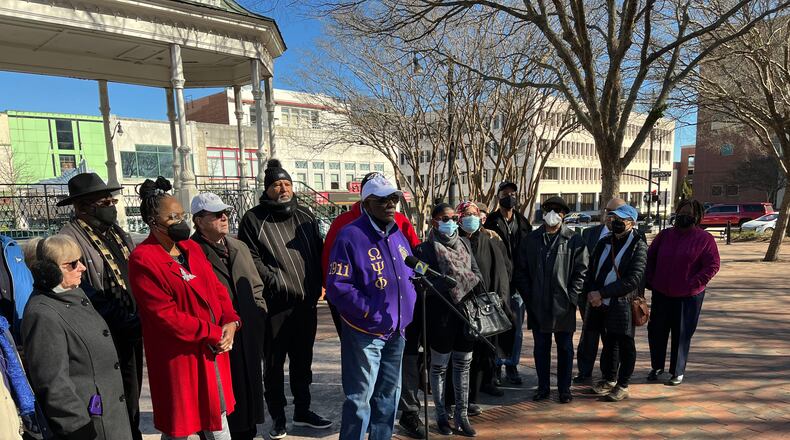When Cobb County voters elect their next local government leaders, they will likely do so in election districts engineered to benefit Republicans.
The Georgia state Senate on Thursday gave final passage to two bills that would significantly reshape the voting districts for the county commission and school board in Cobb County, a growing northwest Atlanta suburb that has shifted over the last decade from GOP stronghold to Democratic control.
Critics say the maps would tip the scales of future elections by diluting the voting power of racial minorities and creating overwhelmingly white districts that are more likely to elect conservative candidates.
An AJC analysis of the commission map found that the proposal would concentrate racial minorities into two districts currently held by Democrats. The changes would give conservatives an advantage in a competitive district held by District 3 Republican JoAnn Birrell by removing thousands of Black and Hispanic voters from her district, and moving them into an overwhelmingly Democratic District 2.
If recent voting trends continue, the map would likely maintain a 50-50 partisan split in the four commission districts of a county that voted for Democratic President Joe Biden by 14 percentage points in 2020.
Democrats would still be favored to retain a 3-2 edge because the chair is elected countywide. Nonetheless, voting rights groups say the proposed map amounts to a power grab by Georgia Republicans, who control the General Assembly and the once-a-decade redistricting process. They also say the changes could violate federal laws aimed at protecting minorities from vote dilution.
“We feel like these actions undermine our democracy,” Julie Bolen, the director of redistricting for the League of Women Voters of Georgia, said at a recent hearing.
The map could effectively kick a sitting Democratic lawmaker out of office two years before her term is supposed to end. The proposal draws Commissioner Jerica Richardson’s home out of District 2, and by county law, commissioners are required to live in the district they represent. Similarly, the map for the GOP-led school board would pit two incumbent Democrats against each other if they both sought reelection.
Cobb County Republicans defended their bills in legislative hearings, saying the maps are fair and constitutional.
Rep. John Carson (R-Marietta), the sponsor of the commission bill, did not respond to multiple messages from the AJC this month seeking comment. But at hearings, he pushed back against characterizations that the map unfairly benefited Republicans.
“Many times when new maps are introduced they’re an attempt to reclaim control of a governing body,” Carson said. “But with this, the Democratic majority on the Cobb County Commission is 3-2. Under this map, it will more than likely stay at a 3-2 majority.”
If Republican Gov. Brian Kemp signs the maps into law, lawsuits are almost certain. Voting rights groups are already suing over proposed congressional and state legislative maps in Georgia that they say discriminate against Black voters. But legal experts told the AJC that even if an electoral map is blatantly tilted to favor one party, it is increasingly difficult to overturn such maps in court.
“It’s really, really, really hard,” said Eric Segall, a law professor at Georgia State University who studies constitutional law. “And it shouldn’t be that way, but it is.”
New districts split along racial lines
In the current map, the districts converge just south of Marietta, dividing the county into four rough geographic quadrants. But they had to be redrawn this year to rebalance the district populations after a decade of growth.
Cobb’s local legislative delegation, controlled by Democrats, offered a map that would have largely kept those districts in place, nudging the lines here and there to ensure each district has about the same population as required by federal law.
The map approved by the local delegation is usually rubber-stamped by the full Legislature. But this year, Republicans bypassed the normal rules in Cobb and other Democratic-led counties like Gwinnett to push through local redistricting plans of their own.
The demographic differences are stark, the AJC’s analysis found. The proposal that’s similar to the current map has one majority-minority district, one largely white district, and two that closely mirror the county’s demographics overall: a little over 50% non-Hispanic whites, and a little under 50% racial minorities.
By contrast, the GOP plan would concentrate white voters in two districts, and minority voters in the other two. Districts 1 and 3 would both be more than 60% white, while Districts 2 and 4 would be more than 60% people of color.
Carson says his map seeks to keep communities of interest, like suburban East Cobb, self-contained within their own districts. But it does so by dividing other communities.
While the new, more conservative District 3 would cover all of East Cobb, District 2 would follow the I-75 corridor. The boundaries would divide Marietta between districts 1 and 2, and split Smyrna between districts 2 and 4.
Democrats: new maps ‘pack and crack’
In redistricting terms, drawing maps in a way that dilutes minority votes is known as “packing and cracking.” Packing means putting large numbers of minority voters in a single district so that their votes are in effect wasted in uncompetitive elections. Cracking means splitting up communities to prevent them from voting in large enough numbers to win an election.
Carson, though, insisted that race was not a factor in how he drew his map. And when told by state Rep. Renitta Shannon (D-Decatur) that his map packs and cracks voters of color, Carson laughed and replied, “I’ve never heard of packing and cracking.”
Critics have seized on his response as evidence that the maps may violate the federal Voting Rights Act, which prohibits diluting minority voting power.
“It casts doubt onto his assertions that this is a fair map, and legally compliant,” Poy Winichakul, a voting rights attorney with the Southern Poverty Law Center, told the AJC. “How can he know that without knowing if this map packs and cracks communities of color?”
But even if it does, Segall, the GSU law professor, said that might not be enough for opponents to win a legal challenge. The Supreme Court in 2018 effectively greenlighted partisan gerrymandering — the practice of drawing district lines in a way that benefits one party over the other. Meanwhile, the Court in a series of decisions has made it harder to overturn a map on the basis of race.
“If you take all of that and put it one big bucket, what you find is that partisan gerrymandering is fine,” Segall said. But, “you’re not going to be able to use race to undo the effects of historical racism.”
And while both parties try to draw maps that give them an edge, on balance Republicans have an advantage nationally because they control more state legislatures, he said.
For Cobb, the map is just the latest in a series of votes by the state Legislature made over the objections of local Democrats. County officials have asked Republican lawmakers to delay three cityhood votes until November, to no avail. The county commission endorsed the local delegation map over the Republican proposal in a party-line, 3-2 vote.
“This just goes to show that partisanship is at its height right now, and local control as we know it is at a low,” said Cobb Chairwoman Lisa Cupid, a Democrat.
About the Author
The Latest
Featured



